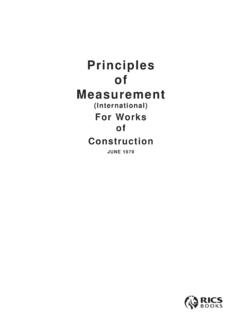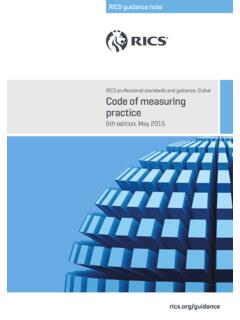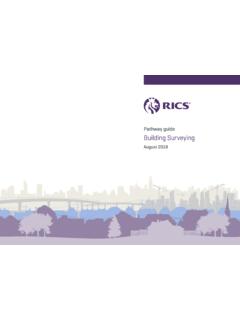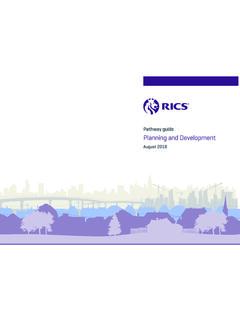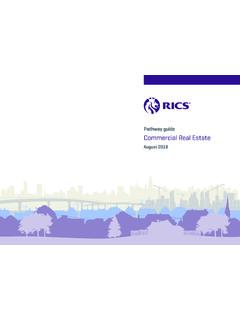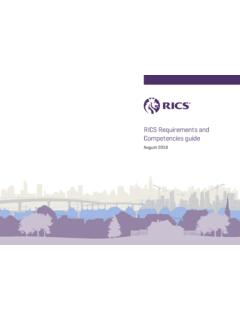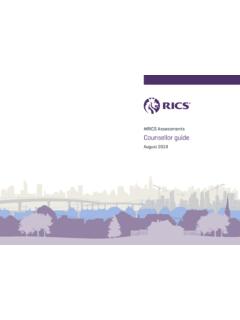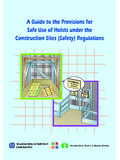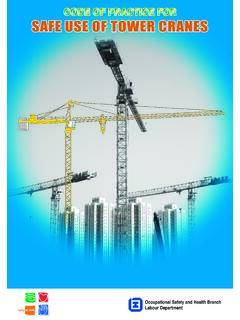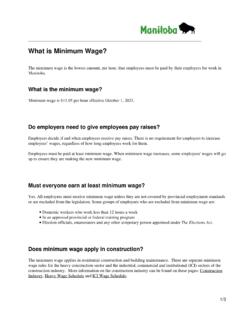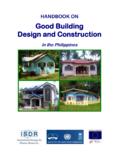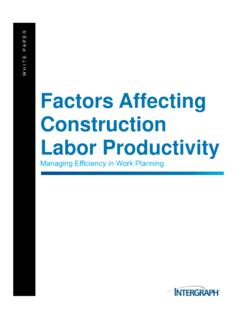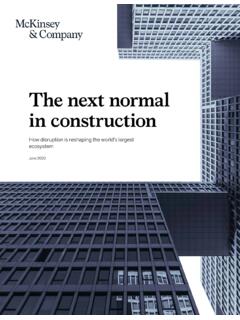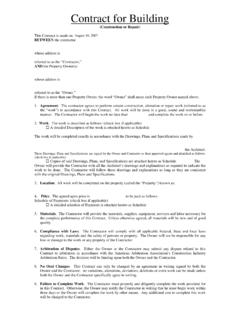Transcription of Modern Methods of Construction - RICS
1 Methods of Construction A forward-thinking solution to the housing crisis? September 20182 Modern Methods of Construction Modern Methods of Construction A forward-thinking solution to the housing crisis? September 20183 Modern Methods of Construction author would like to thank each of the contributors to this document for their time and assistance in compiling these case by the Royal Institution of Chartered Surveyors (RICS)RICS, Parliament Square, London SW1P 3AD The views expressed by the author are not necessarily those of RICS nor any body connected with RICS. Neither the author, nor RICS accept any liability arising from the use of this RICS 2018 Report for RICSR eport written by:Alex DaviesRICS MMC AdvisorRICS International Standards TeamPaul BagustGlobal Property Standards BasquillGlobal Property Standards Associate Methods of Construction ContentsForeword.
2 5 Introduction ..61 Cross-laminated timber a forward-thinking solution to the housing crisis? ..82 Modular Construction and build-to-rent accelerating house building ..183 Modular Construction in housing and beyond ..244 Timber frame an environmentally and economically proven solution ..325 Affordable housing how offsite Construction is helping first-time buyers afford their own home ..406 DfMA how manufacturing and Construction combine to create 21st century efficiency ..477 Tailor-made how offsite Construction can help fund social to action ..60 5 Modern Methods of Construction UK Construction sector is a strategically significant part of the UK economy.
3 Representing 8% of GDP and 9% of employment, every year 150 billion is invested through the public and private sectors. It is not only important in terms of its contribution to economy, it is also an enabler of wider economic growth and development, providing the homes, infrastructure and environment that allows the nation to function and sector has been struggling however, to meet growing demand for its services in residential, with issues such as supply and demand imbalances which contribute to unaffordability and in extremis, homelessness. Market-led solutions alone have not met the needs of large segments of the population, as housing affordability has moved beyond the reach of so many.
4 The Construction sector for residential is part of the challenge. It is characterised by low productivity, variable quality, output lagging behind target, and slim margins for builders. This is partly due to the cyclical nature of the residential sales-led trader model, creating unstable foundations for the Construction sector to operate and invest in. Offsite manufacture represents an opportunity to address many of these issues in addition to increasing capacity and investment in the industry. Its properties and characteristics can supplement our existing capacities, supporting alternative models for delivery and allowing for more options to be considered when tackling the complicated process of housebuilding.
5 However, it is not a panacea that will resolve all the problems in the sector, but, once fully embedded, will go some way to improving our capacity to meet Buildoffsite Property Assurance Scheme (BOPAS) accreditation of non-traditional build, was one of the first systematic attempts to help mainstream MMC. This offered durability and maintenance assessment carried out by Building Life Plans Ltd (BLP), process accreditation carried out by Lloyds Register, and a web enabled database providing valuers, lenders and surveyors with details of housing units by scheme. Launched in 2013, having been jointly developed by Buildoffsite, RICS, Lloyd s Register and BLP Insurance, in consultation with the Council of Mortgage Lenders (now integrated into UK Finance) and the Building Societies Association (BSA), the scheme seeks to address confidence issues with MMC.
6 We now recognise that we need to increase support for MMC to make it a much more prominent part of the UK s Construction capacity. This RICS report showcases some of the potential benefits and impacts of the technologies on offer. While there is already take-up of the technology and some adoption in the market, more can be done to eradicate obstacles and speed up the growth of the sector. The research provides clear evidence and best practice examples on which to base future MMC strategy for both industry and thank those who have participated in the interviews for taking the trouble to engage with us. Mike Basquill MRICS Global Property Standards Associate Director, RICS 6 Modern Methods of Construction Introduction The demands on the residential Construction sector are substantial.
7 At a time when we are facing a skills shortage, we have increasing workloads and aspirations to deliver ambitious infrastructure projects and targets alongside other modernisation goals such as improving productivity. A key issue at play, beyond planning and developers business planning, is industry capacity. In his 2016 report about the Construction industry, Modernise or Die, Mark Farmer identified a skills crisis in mainstream Construction , likely to result in a decrease of 20-25% in the workforce over the next decade. The workforce is ageing, and the rate of new entrants is lagging behind those leaving. This is likely to be exacerbated by Brexit, as one in eight UK Construction workers are foreign, rising to around one in four in London.
8 In addition, the weakening pound has increased the cost of imported materials, with some 20% of bricks and brick-making components imported, mostly from the EU. Recognising some of these problems, on 5th July 2018 the Government and the Construction Leadership Council published the Construction Sector Deal, allocating 420m in support of industry sector deal is based on three simple principles: Digitising Delivering better, more certain outcomes using digital technologies; Manufacturing Improving productivity, quality and safety by increasing the use of manufacturing; and Performance Optimising whole life performance through the development of energy efficient, smart are applied to five key themes: Ideas investment in the development of digital and manufacturing-based approaches to Construction ; People reforming industry recruitment and training to attract, retain and develop the skills that the industry needs; Infrastructure taking forward the investment set out in the National Infrastructure and Construction Pipeline; Business environment developing a sustainable business model for Construction and establishing the UK as a global leader in infrastructure delivery.
9 And Places working across the sector to strengthen the supply chain and skills base across the UK. MMC resonates with all these principles and themes. As a consequence of using manufacturing production Methods , the workflow is significantly different to traditional building. As much more of the production value comes at the design and assembly phase, digitisation and efficiency gains are achievable. This paper explores some of the potential issues and opportunities that MMC offers. By examining a series of case studies where BOPAS-accredited MMC variants have been deployed, we explore the pros and cons of the technologies on offer. We round off the studies with a call for action on various fronts, recognising that though MMC is not a panacea, it can play a substantial role in solving the problems we face in property and drive towards mainstreaming MMC is building momentum.
10 This paper seeks to highlight this and add further momentum. Drivers of changeA combination of acute housing demand and market failures in terms of cost, quantity and quality, are forcing the industry and government to look at MMC as a solution. This has culminated in Government including MMC in major housing strategy announcements, recognising that it has the potential to speed up delivery, improve productivity and modernise the sector. The reason for such faith being placed on MMC can be attributed to three key elements reflecting the three principles driving the sector deal: Digitisation, Manufacturing and Performance. The utilisation of pre-manufacturing technologies brings Construction into the Modern age by transferring production to the factory.

